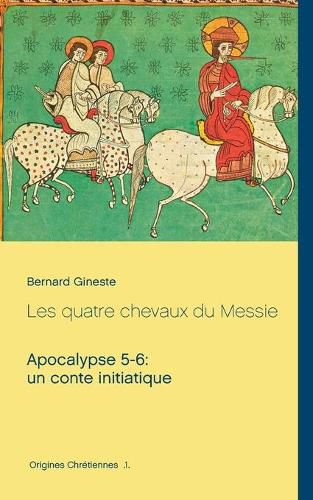Readings Newsletter
Become a Readings Member to make your shopping experience even easier.
Sign in or sign up for free!
You’re not far away from qualifying for FREE standard shipping within Australia
You’ve qualified for FREE standard shipping within Australia
The cart is loading…






This title is printed to order. This book may have been self-published. If so, we cannot guarantee the quality of the content. In the main most books will have gone through the editing process however some may not. We therefore suggest that you be aware of this before ordering this book. If in doubt check either the author or publisher’s details as we are unable to accept any returns unless they are faulty. Please contact us if you have any questions.
Sommaire Tout le monde a entendu parler des Quatre cavaliers de l'Apocalypse . Le recit de cette vision de Jean a une structure tres simple, du type des contes de fees. Mais c'est aussi une meditation des Ecritures centree sur le chapitre 53 du Livre du prophete Isaie. Un personnage trop neglige, l'un des vingt-quatre Anciens , guide celeste de Jean, s'avere etre Isaie lui-meme. Comme la fee marraine de Cendrillon, Isaie apparait a son successeur Jean pour l'assister, et, comme elle, il preside a d'etranges metamorphoses qui preparent un mariage. Le Messie, d'abord a la fois Lion et Racine, se transforme en un Agneau egorge, puis en un Cavalier qui monte tour a tour quatre chevaux respectivement blanc, rouge, noir puis verdatre. Le code tres precis de ces couleurs successives est tire du Levitique (manuel des pretres pour l'identification des lepreux) et du chapitre 5 du Cantique des cantiques (portrait de l'Epoux par sa Bien-Aimee). Ces quatre chevauchees representent donc la carriere terrestre du Messie de l'an 29 a l'an 33, car, selon Isaie 53,4, il devait etre considere comme un lepreux et rejete par les autorites religieuses etablies, avant d'etre reconnu comme le Messie par son epouse l'Eglise chretienne. Summary In what context do the so-called Four Horsemen of the Apocalypse arise ? First a basic narrative scheme as in the fairy tale genre, then a meditation centered on Isaiah 53. An under-studied character, one of the twenty-four elders , John’s heavenly guide, turns out to be Isaiah himself. Like Cinderella’s Fairy Godmother, he presides over metamorphoses: The Messiah becomes both a Lion and a Root, then a Lamb, then a Horseman riding four horses one after the other. The code of their successive colors, white-red-black-greenish, is taken from Leviticus 13 (the priests’ handbook for the identification of lepers) and from Song 5, 10-12 (portrait of the Husband by his Beloved). So they are the four years of the earthly career of the Messiah, who accordi
$9.00 standard shipping within Australia
FREE standard shipping within Australia for orders over $100.00
Express & International shipping calculated at checkout
This title is printed to order. This book may have been self-published. If so, we cannot guarantee the quality of the content. In the main most books will have gone through the editing process however some may not. We therefore suggest that you be aware of this before ordering this book. If in doubt check either the author or publisher’s details as we are unable to accept any returns unless they are faulty. Please contact us if you have any questions.
Sommaire Tout le monde a entendu parler des Quatre cavaliers de l'Apocalypse . Le recit de cette vision de Jean a une structure tres simple, du type des contes de fees. Mais c'est aussi une meditation des Ecritures centree sur le chapitre 53 du Livre du prophete Isaie. Un personnage trop neglige, l'un des vingt-quatre Anciens , guide celeste de Jean, s'avere etre Isaie lui-meme. Comme la fee marraine de Cendrillon, Isaie apparait a son successeur Jean pour l'assister, et, comme elle, il preside a d'etranges metamorphoses qui preparent un mariage. Le Messie, d'abord a la fois Lion et Racine, se transforme en un Agneau egorge, puis en un Cavalier qui monte tour a tour quatre chevaux respectivement blanc, rouge, noir puis verdatre. Le code tres precis de ces couleurs successives est tire du Levitique (manuel des pretres pour l'identification des lepreux) et du chapitre 5 du Cantique des cantiques (portrait de l'Epoux par sa Bien-Aimee). Ces quatre chevauchees representent donc la carriere terrestre du Messie de l'an 29 a l'an 33, car, selon Isaie 53,4, il devait etre considere comme un lepreux et rejete par les autorites religieuses etablies, avant d'etre reconnu comme le Messie par son epouse l'Eglise chretienne. Summary In what context do the so-called Four Horsemen of the Apocalypse arise ? First a basic narrative scheme as in the fairy tale genre, then a meditation centered on Isaiah 53. An under-studied character, one of the twenty-four elders , John’s heavenly guide, turns out to be Isaiah himself. Like Cinderella’s Fairy Godmother, he presides over metamorphoses: The Messiah becomes both a Lion and a Root, then a Lamb, then a Horseman riding four horses one after the other. The code of their successive colors, white-red-black-greenish, is taken from Leviticus 13 (the priests’ handbook for the identification of lepers) and from Song 5, 10-12 (portrait of the Husband by his Beloved). So they are the four years of the earthly career of the Messiah, who accordi